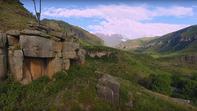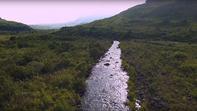Individual Route
This hike is from up the Injisuthi Valley and is an 11km return. The hike can take up to 5 hours including the cave tour. You can walk this route on your own as it is also the way to Lower Injisuthi cave for which you don't need a guide, but Battle Cave is fenced off and locked and you can see the rock art there only on a guided tour.

Although this hike is guided, directions are included so that you know about it and because this is the 'gateway' to most of the Injisuthi hiking area. Start on the main road leading out of camp and just before the vehicle bridge turn right up the embankment, then along a slope and after 1 km down into the Injisuthi Valley.
Follow the path up the right-hand bank of the river for 1.5 km to where it enters a large forest, but only briefly, wends along a muddy course before exiting and crossing the Injisuthi by some stepping stones. In the rainy season you are most likely going to get your feet wet.
You're Heading Upstream

From the river the path heads up a grassy slope for 400 m, as if heading for the sandstone mass ahead. However, on reaching a platform level the well-maintained path turns right and for the next 1 km sails a level course to bring you back to the river bank (look out for the split boulder housing a yellowwood).
Since you're heading upstream the path will naturally rise, but never require much effort. In spring and summer the path is lined with beautiful blue scilla lilies, while in late summer and autumn the bottlebrushes come into brilliant scarlet bloom. Across the river you can see the 'teeth rocks' biting out from the forest.
The path follows the Injisuthi River for a few hundred metres more, then follows the lie of the land into the eMbovaneni side valley for a distance, crosses this stream and wends its way back into the main valley to reach Battle Cave after 5.5 km. This should take about 2 hours. The interpretation of this important art site, however, was not accurate. It is a metaphorical battle more to do with the power of magic than bows and arrows.
By David Bristow